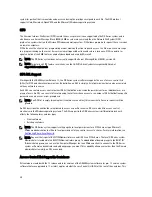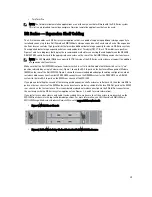
During replication, the system processes data storage requests from a specified source to a specified destination (also
known as a target) that acts as a replica of the original source data.
NOTE: Starting with Release 2.0, the DR Series system software includes version checking that limits replication
only between other DR Series systems that run the same system software release version (DR Series systems
running Release 2.0.x software can only replicate with other DR Series systems that run the same release system
software). For example, Release 2.0.x systems will not be able to replicate with Release 2.1 or Release 3.0 systems,
but can replicate with systems running Release 2.0.0.1 or 2.0.0.2.
NOTE: It is important to distinguish the difference between data that has been processed by backup and data that
has been processed by replication, since backup saves a copy of data that remains unchanged for a long period of
time.
Targets with replica data are read-only, and are updated with new or unique data during scheduled or manual
replications. The DR Series system can be considered to act as a form of the storage replication where the backed up
and deduplicated data is replicated in real-time or via a scheduled window. In a replication relationship between two DR
Series systems, this means that a relationship exists between a pair of systems, one acting as the source and the other
as a target in the replication pair (for example, with acme-west and acme-east). When this type of replication
relationship exists between distinct containers on two distinct DR Series systems, it can be considered bidirectional in
the sense that:
•
West1 container on the acme-west source system can replicate data to a separate East1 container on the
acme-east target system.
•
The East2 container on the target acme-east system can also replicate data back to the West2 container on the
source acme-west system.
This form of replication involves separate containers on two distinct DR Series systems. Target containers in replication
must always act as read-only, while source containers can act as read-write. Unlike NFS and CIFS containers, OST
container replication is handled by the two supported Data Management Applications (DMAs) on media servers. For
details, see
Understanding OST
.
This release of the DR Series system supports the 32:1 replication of data, whereby up to 32 source DR Series systems
can write data to different individual containers on a single, target DR Series system. This supports the use case where
branch or regional offices can each write their own data to a separate, distinct container on a main corporate DR Series
system.
NOTE: Be aware that the storage capacity of the target DR Series system is directly affected by the number of
source systems writing to its containers, and by the amount being written by each of the source systems.
If the source and target systems in a replication pair reside in different Active Directory (AD) domains, then the data that
resides on the target DR Series system may not be accessible. When AD is used for authentication for DR Series
systems, the AD information is saved with the file. This can serve to restrict user access to the data based on the type of
AD permissions that are in place.
NOTE: This same authentication information is replicated to the target DR Series system when you have replication
configured. To prevent domain access issues, ensure that both the target and source systems reside in the same
Active Directory domain.
Reverse Replication: The concept of reverse replication is not supported on DR Series systems. This is because replica
containers are always in a R-O (read-only) mode on the DR Series system, thus making write operations a non-
supported operation. Under very specific conditions, it might be possible for replica containers to support a type of write
operation whose sole function is to restore data from an archival target. For example, data could be replicated back to
the remote site where a data management application (DMA), also known as backup software, is connected to allow
this data to be restored directly.
This specific case applies only to configurations where data is backed up from a remote location to a local container,
and then replicated over a WAN to a replica container that is backed up to tape. The data needs to be restored from the
15
Summary of Contents for PowerVault DX6112
Page 1: ...Dell DR Series System Administrator Guide ...
Page 32: ...32 ...
Page 70: ...70 ...
Page 86: ...86 ...
Page 100: ...For more information on Replication schedules see Creating a Replication Schedule 100 ...
Page 114: ...114 ...
















































